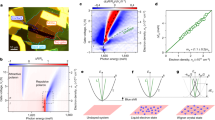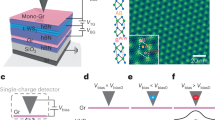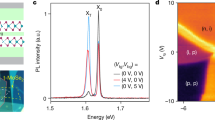Abstract
Photoemission and tunnelling spectroscopies measure the energies at which single electrons can be added to or removed from an electronic system1. Features observed in such spectra have revealed electrons coupling to vibrational modes of ions both in solids2 and in individual molecules3. Here we report the discovery of a sharp resonance in the tunnelling spectrum of a two-dimensional electron system. Its behaviour suggests that it originates from vibrational modes, not involving ionic motion, but instead arising from vibrations of spatial ordering of the electrons themselves. In a two-dimensional electronic system at very low temperatures and high magnetic fields, electrons can either condense into a variety of quantum Hall phases or arrange themselves into a highly ordered ‘Wigner’ crystal lattice4,5,6. Such spatially ordered phases of electrons are often electrically insulating and delicate, and have proven very challenging to probe with conventional methods. Using a pulsed tunnelling method capable of probing electron tunnelling into insulating phases, we observe a sharp peak with dependencies on energy and other parameters that fit to models for vibrations of a Wigner crystal7,8. The remarkable sharpness of the structure presents strong evidence of the existence of a Wigner crystal with long correlation length.
This is a preview of subscription content, access via your institution
Access options
Subscribe to this journal
Receive 12 print issues and online access
$259.00 per year
only $21.58 per issue
Buy this article
- Purchase on SpringerLink
- Instant access to full article PDF
Prices may be subject to local taxes which are calculated during checkout




Similar content being viewed by others
References
Wolf, E. L. Principles of Electron Tunneling Spectroscopy (Oxford Univ. Press, 2011).
Rowell, J. M., McMillan, W. L. & Feldmann, W. L. Phonon emission and self-energy effects in normal-metal tunneling. Phys. Rev. 180, 658–668 (1969).
Stipe, B. C., Rezaei, M. A. & Ho, W. Single-molecule vibrational spectroscopy and microscopy. Science 280, 1732–1735 (1998).
Wigner, E. On the interaction of electrons in metals. Phys. Rev. 46, 1002–1011 (1934).
Lozovik, Y. E. & Yudson, V. I. Crystallization of a two-dimensional electron gas in a magnetic field. JETP Lett. 22, 274–276 (1975).
Fertig, H. A. in Perspectives in Quantum Hall Effects (eds Sarma, S. D. & Pinczuk, A.) 71–108 (Wiley, 1996).
Bonsall, L. & Maradudin, A. A. Some static and dynamical properties of a two-dimensional Wigner crystal. Phys. Rev. B 15, 1959–1973 (1977).
Cǒté, R. & MacDonald, A. H. Phonons as collective modes: the case of a two-dimensional Wigner crystal in a strong magnetic field. Phys. Rev. Lett. 65, 2662–2665 (1990).
Maki, K. & Zotos, X. Static and dynamic properties of a two-dimensional Wigner crystal in a strong magnetic field. Phys. Rev. B 28, 4349–4356 (1983).
Chang, C.-C., Jeon, G. S. & Jain, J. K. Microscopic verification of topological electron-vortex binding in the lowest Landau-level crystal state. Phys. Rev. Lett. 94, 016809 (2005).
Archer, A. C., Park, K. & Jain, J. K. Competing crystal phases in the lowest Landau level. Phys. Rev. Lett. 111, 146804 (2013).
Andrei, E. Y. et al. Observation of a magnetically induced Wigner solid. Phys. Rev. Lett. 60, 2765–2768 (1988).
Jiang, H. W. et al. Quantum liquid versus electron solid around ν = 1/5 Landau-level filling. Phys. Rev. Lett. 65, 633–636 (1990).
Goldman, V. J., Santos, M., Shayegan, M. & Cunningham, J. E. Evidence for two-dimentional quantum Wigner crystal. Phys. Rev. Lett. 65, 2189–2192 (1990).
Piot, B. A. et al. Wigner crystallization in a quasi-three-dimensional electronic system. Nat. Phys. 4, 936–939 (2008).
Chen, Y. et al. Microwave resonance of the 2D Wigner crystal around integer Landau fillings. Phys. Rev. Lett. 91, 016801 (2003).
Tiemann, L., Rhone, T. D., Shibata, N. & Muraki, K. NMR profiling of quantum electron solids in high magnetic fields. Nat. Phys. 10, 648–652 (2014).
Zhang, D., Huang, X., Dietsche, W., von Klitzing, K. & Smet, J. H. Signatures for Wigner crystal formation in the chemical potential of a two-dimensional electron system. Phys. Rev. Lett. 113, 076804 (2014).
Johansson, P. & Kinaret, J. M. Tunneling between two two-dimensional electron systems in a strong magnetic field. Phys. Rev. B 50, 4671–4686 (1994).
Dial, O. E., Ashoori, R. C., Pfeiffer, L. N. & West, K. W. High-resolution spectroscopy of two-dimensional electron systems. Nature 448, 176–179 (2007).
Dial, O. E., Ashoori, R. C., Pfeiffer, L. N. & West, K. W. Anomalous structure in the single particle spectrum of the fractional quantum Hall effect. Nature 464, 566–570 (2010).
Gallais, Y., Yan, J., Pinczuk, A., Pfeiffer, L. N. & West, K. W. Soft spin wave near ν = 1: evidence for a magnetic instability in skyrmion systems. Phys. Rev. Lett. 100, 086806 (2008).
Gervais, G. et al. Evidence for skyrmion crystallization from NMR relaxation experiments. Phys. Rev. Lett. 94, 196803 (2005).
Davis, L. C. & Duke, C. B. Analysis of the tunneling measurement of electronic self-energies due to interactions of electrons and holes with optical phonons in semiconductors. Phys. Rev. 184, 764–779 (1969).
Ashoori, R. C., Lebens, J. A., Bigelow, N. P. & Silsbee, R. H. Equilibrium tunneling from the 2-dimensional electron-gas in GaAs—evidence for a magnetic-field-induced energy-gap. Phys. Rev. Lett. 64, 681–684 (1990).
Millis, A. J. & Littlewood, P. B. Radio-frequency absorption as a probe of the transition between the Wigner crystal and the fractionally quantized Hall state. Phys. Rev. B 50, 17632–17635 (1994).
Côté, R. et al. Collective excitations, NMR, and phase transitions in skyrme crystals. Phys. Rev. Lett. 78, 4825–4828 (1997).
Sondhi, S. L., Karlhede, A., Kivelson, S. A. & Rezayi, E. H. Skyrmions and the crossover from the integer to fractional quantum Hall effect at small Zeeman energies. Phys. Rev. B 47, 16419–16426 (1993).
Schmeller, A., Eisenstein, J. P., Pfeiffer, L. N. & West, K. W. Evidence for skyrmions and single spin flips in the integer quantized Hall effect. Phys. Rev. Lett. 75, 4290–4293 (1995).
Fogler, M. M., Koulakov, A. A. & Shklovskii, B. I. Ground state of a two-dimensional electron liquid in a weak magnetic field. Phys. Rev. B 54, 1853–1871 (1996).
Acknowledgements
The work at MIT was funded by the BES Program of the Office of Science of the US DOE, contract no. FG02-08ER46514, and the Gordon and Betty Moore Foundation, through grant GBMF2931. The work at Princeton University was funded by the Gordon and Betty Moore Foundation through the EPiQS initiative Grant GBMF4420, and by the National Science Foundation MRSEC Grant DMR-1420541. We thank P. A. Lee and I. Sodemann for helpful conversations. We thank N. Staley for a careful proofreading of the manuscript and A. Demir for assistance in amplifier design.
Author information
Authors and Affiliations
Contributions
J.J. and B.M.H. performed measurements. J.J. and R.C.A. analysed data. K.W.W. and L.N.P. grew GaAs/AlGaAs heterostructures. All authors discussed the results. J.J. and R.C.A. wrote the paper, and R.C.A. supervised the overall project.
Corresponding authors
Ethics declarations
Competing interests
The authors declare no competing financial interests.
Supplementary information
Supplementary information
Supplementary information (PDF 1534 kb)
Rights and permissions
About this article
Cite this article
Jang, J., Hunt, B., Pfeiffer, L. et al. Sharp tunnelling resonance from the vibrations of an electronic Wigner crystal. Nature Phys 13, 340–344 (2017). https://doi.org/10.1038/nphys3979
Received:
Accepted:
Published:
Issue date:
DOI: https://doi.org/10.1038/nphys3979
This article is cited by
-
Direct observation of a magnetic-field-induced Wigner crystal
Nature (2024)
-
A highly correlated topological bubble phase of composite fermions
Nature Physics (2023)
-
Strong correlations in two-dimensional transition metal dichalcogenides
Science China Physics, Mechanics & Astronomy (2023)
-
Competing correlated states around the zero-field Wigner crystallization transition of electrons in two dimensions
Nature Materials (2022)
-
A long-sought regime of electronic behaviour
Nature Materials (2022)



